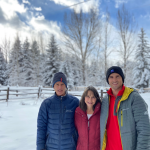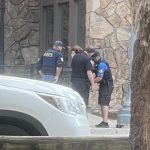Pandemic puts Aspen schools to the test with newcomers, in-person class and a ballot initiative
Just a couple of months ago as the Aspen School District was preparing for an enrollment surge of up to 150 students, a Los Angeles family was also trying to figure out what to do next.
They were staying at a family home in Aspen in August, as they’ve done in recent years before the kids start school in L.A. Hearing about how the elementary school here was getting back to school, however, gave them pause about returning to the West Coast where their lifestyle was deteriorating because of the lockdown as well as other events including wildfires and social unrest.
“It was the perfect storm of reasons to stay in Aspen,” said parent Lexy Leibovich who is raising a daughter and son with his wife, Miranda Bailey, a Colorado native.
The ASD’s plan was for half of the school’s kids to attend class two days a week and learn remotely two other days; the other half would reciprocate on alternate weeks. Students also could opt for online learning exclusively, while Wednesdays would be days for teacher planning.
Compared to the burdensome learning environment in Los Angeles, Aspen Elementary School was well worth the shot for Goldie Leibovich, who entered the fourth grade this fall. Each of her seven online classes out of L.A. required a separate check-in for each new teacher. The cumbersome arrangement made learning difficult and demanded her parents’ monitoring.
“This is so much easier to navigate,” the older Leibovich said of Aspen Elementary’s hybrid-class approach so far this fall. “Instead of me sitting by her side every 30 minutes for a new teacher, I sit by her side for that first class and pack her school work for the rest of the week. … They’ve really made it easy to understand with all of the complexities.”
Since beginning in-person class Sept. 8, the elementary school has remained open without having to close cohorts or classes due to an outbreak or spread.
School has gone so well for Goldie that her brother, Wilder, is enrolling in the seventh grade at the middle school, which with the high school are scheduled to start in-person class Oct. 26. The two schools also will use a hybrid system, with cohorts alternating online and in-person classes one week at a time.
The two new students Goldie and Wilder, however, are hardly part of what district officials thought might be an enrollment surge to complement the surge in demand in the housing market.
Instead of another 150 students added to the district’s roster, enrollment ended up slipping by 20 to 25 students from the 2018-19 year, according to Superintendent David Baugh.
“Everybody is down a little bit,” Baugh said, “and we’re down 20 to 25 kids last year. We did get a fair number of folks move in and then withdraw (from enrollment).”
The state already has conducted its October student count to determine per-pupil funding. Aspen has 443 students in the elementary school, 447 in the middle school, and 555 in the high school.
News of the enrollment decline “is not great,” said school board member Susan Zimet, noting that “I don’t think anybody thought all of those out-of-towners were going to stay. … We knew a lot were forming (private learning) pods.”
Money, however, has been pouring into residential real estate sales this summer, which saw $1.5 billion in transactions from July to September.
The district is supported by property taxes, and this November goes to voters with a $94 million bond proposal. Also, voters in the Aspen and Snowmass Village municipalities will be asked to extend their respective sales and property taxes supporting the district.
Before the school board approved bringing the bond question to voters, the district conducted a survey in August with 69% of the respondents saying they have children in the school district, and another 63% saying they would “definitely” or “probably” vote in favor of the bond question. The district received a 6.5% response rate with the surveys — seeing a return of 437 of the 6,720 questionnaires sent to households with at least one registered voter.
All, however, hasn’t been rosy in the school community since the pandemic broke.
The decision to reopen the middle and high schools the last week of October — so long as public health trends cooperate — has gained overall acceptance from the teachers, with some opting to work from home to limit interaction with students out of health concerns. Teachers with children in school also have faced the double-task of making sure their own kids are on the right track online while monitoring the students they are paid to teach.
The road to reaching a consensus included many parents pushing for an earlier opening, saying teachers have a responsibility as essential workers to teach in-person class.
Last week, a group of 20 pediatricians in the Roaring Fork Valley sent an open letter to the community imploring for public schools to open immediately. It would be better for children’s overall health to attend school than to prolong at-home learning, the letter said.
“Although originally necessary to protect the health and safety of our community, it is clear that shutting schools has had negative impacts on students and their families,” the letter said. “Depression, suicide attempts, child abuse and domestic violence have increased dramatically nationwide. Despite the best efforts of our teachers, online learning cannot adequately provide individualized attention, equal learning opportunities, nutrition, or the social and emotional benefits of attending school in person.
A recently completed survey by ASD also saw 91.4% of 698 responding parents say they would send their children to school either through the hybrid approach or full time. In another question, 10.5% of 702 respondents said they would be “very interested” in their kids in K-8 continuing their studies online.
Teachers have said certain parents and even board members lack empathy and understanding of their challenges to effectively teach — while wearing masks, socially distancing, etc. — against the backdrop of a public health crisis.
As a compromise of sorts, the district pegged Oct. 26 to open because that’s when the second quarter begins, and it also gives it the time needed to improve the air quality in the elementary school building, which will need to accommodate a greater number of students when the secondary schools open. That’s because elementary students have been spread across classrooms in the elementary, middle and high schools since starting in-person class last month.
“I think our superintendent made the right call when we learned there were not all of the protocols that are critical in the first place in at least one of the schools,” said Zimet said, referring to the elementary school’s inadequate HVAC. “I think he had no choice but to delay the opening because of that and well as the end of the first quarter.”
Yet there’s been enough frustration expressed by the parents to have bond-question advocates concerned.
The Aspen community traditionally supports school finance questions, with voters passing a $33 million bond proposal in 2005 and another one for $12 million in 2008.
The current campaign is focussing on hiring and retaining quality teachers by building housing with the bond dollars, which also would focus on bringing capital improvements to the campus.
Baugh, who became district superintendent July 1, said the bond initiative had been in works before the pandemic struck in March, “and I’m guardedly optimistic that the community will take the long view that this is really important for all of us.”
“I think it will be closer than usual because there has been some strife, but we are opening and it’s really time for us all to pull together and it’s not teacher-versus-parent, it’s no any of us versus any of us. We just have to keep that in mind and do the right thing for the kids. The kids are going to keep coming here and we’re going to keep educating them.”
PHOTOS: Closing day party on Ajax brings end to Aspen’s ski season
The ski season is officially a wrap here in the Roaring Fork Valley, with Sunday’s annual closing day party on Aspen Mountain the winter’s final hurrah.























